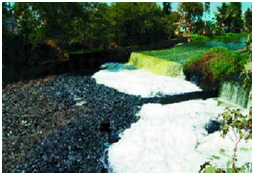
Oil pollution killing Bengaluru’s biggest lake
March 11, 2013
http://www.ehsnews.org
Bengaluru: Yet another water body is dying in a city that once boasted having 250-plus water bodies. This time it’s the largest lake in Bengaluru, which shows lethal doses of oil pollution, probably from industrial waste, garbage and sewage.
Researchers from the Department of Environmental Science, Bangalore University, have recorded increased amount of oil contamination in Bellandur Lake, which is polluting both the lake water and the underlying water table of areas around the lake.
Water samples from the lake were analysed for pH, electrical conductivity and total dissolved solids, turbidity, total hardness, chlorides, fluoride, sulphates, phosphates, potassium, and sodium.
As per Drinking water specifications, the standard for total dissolved solids (TDS) is 500 milligrams per litre whereas the tests showed 600 mg/L. High levels of dissolved solids is harmful for human and aquatic life.
“This indicates the presence of a pollution inflow, generally raw sewage or industrial effluents. A high level of dissolved solids elevates the density of water which influences osmoregulation of fresh water organisms, reducing the solubility of gases like oxygen and utility of water for irrigation and industrial purposes,” Dr N. Nandini, chairperson and principal investigator, Department of Environmental Science, BU, told Deccan Chronicle.
“Urban water bodies have become dumping grounds for untreated sewage and garbage of the city and this is due to lack of scientific management approaches by planners and comprehensive action plans.
Stress to lakes arises from easily identifiable point sources such as municipal and industrial wastewater, and non-point sources such as urban and agricultural run-off within a lake's watershed, and insidious long-range atmospheric transport of contaminants,” explained Dr Nandini.
The researchers from BU want government bodies to check the contamination as the Bellandur Lake water is used for irrigation in the downstream areas and for fishing.
“The lake is surrounded by a residential layout to the south side, Hindustan Aeronautical Limited (HAL) to the north, and the Embassy Golf links to the north-west. The major threat to the water body is direct entry of sewage,” Dr Nandini added.
The researcher hinted that the lake has an inlet from the HAL compound, and could be releasing the oil into the lake. However, HAL has denied that the company causes any contamination. “Like all other defence units we have treatment plants before we release anything liquid into the lake,” said a spokesperson for HAL.